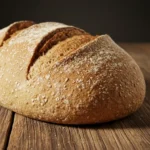Sourdough bread isn’t just your average loaf it’s a flavorful, gut-friendly classic that has stood the test of time. From artisanal bakeries to home kitchens, sourdough bread has taken over shelves and hearts with its tangy taste, crusty exterior, and chewy inside.
But there’s more to it than taste. This article dives deep into everything you need to know about sourdough bread from its benefits and science to its role in modern nutrition and baking culture.
In the coming sections, you’ll uncover how to make the perfect loaf, learn the truth about its carbs, and discover why sourdough might be the best bread for your health. You’ll also get answers to common questions like whether sourdough is anti-inflammatory, good for diabetics, and even helpful for losing belly fat.
Let’s kick things off with the basics: how sourdough is made and what makes it so special.
Table of Contents
Table of Contents
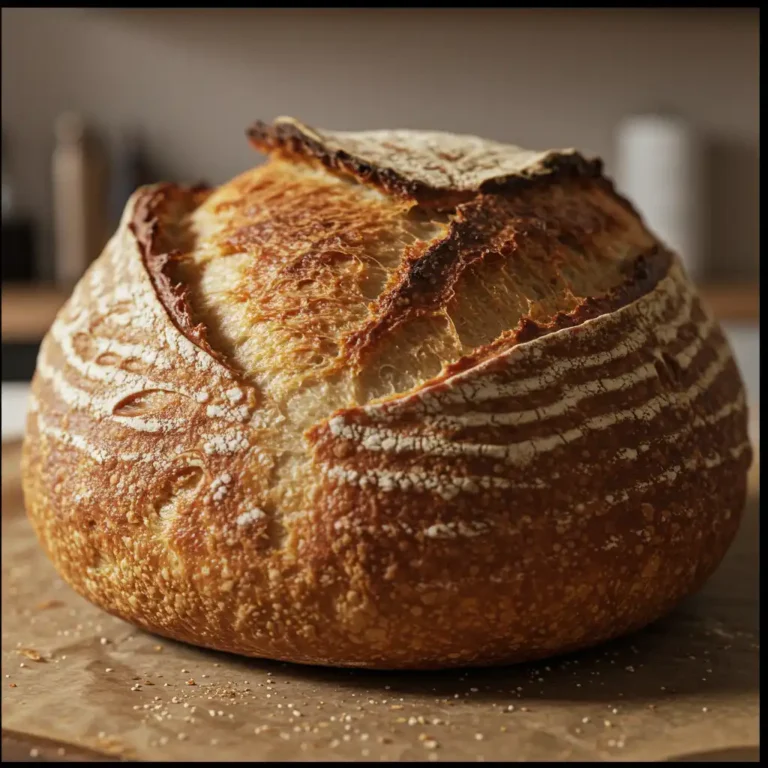
Sourdough Bread: Why It’s More Than Just a Trend
Sourdough bread is more than a baking trend it’s a return to real, slow-crafted food. Naturally fermented with a wild yeast starter, this rustic loaf offers a chewy crumb, tangy flavor, and a beautiful crust. Perfect for toast, sandwiches, or enjoying warm with butter, sourdough is as delicious as it is nutritious. This recipe walks you through every step to create bakery-quality sourdough bread at home, even if you’re a beginner.
- Total Time: 12 hours 45 minutes
- Yield: 1 large loaf 1x
Ingredients
100g active sourdough starter (fed and bubbly)
375g filtered water (lukewarm)
500g bread flour (or a mix of bread and whole wheat flour)
10g fine sea salt
Instructions
1. Mix the Dough
In a large bowl, mix the sourdough starter with water. Stir to dissolve. Add the flour and combine until no dry flour remains. Let it rest for 45 minutes (autolyse).
2. Add Salt
Sprinkle salt over the dough and gently knead it in. Let the dough rest for 30 minutes.
3. Stretch and Fold
Over the next 2 to 3 hours, perform 3–4 sets of stretch-and-folds every 30 minutes to build gluten structure.
4. Bulk Fermentation
Cover the bowl and let the dough rise at room temperature (70–75°F) for 4 to 6 hours, or until it has roughly doubled in size.
5. Shape the Dough
Turn the dough out onto a lightly floured surface. Pre-shape into a round, rest for 20 minutes, then shape into a tight boule or batard.
6. Second Rise
Place dough seam-side up in a floured banneton or bowl lined with a floured towel. Cover and refrigerate overnight (8–12 hours).
7. Preheat and Bake
Preheat oven to 475°F (245°C) with Dutch oven inside. Score the loaf and transfer to the hot Dutch oven. Bake 20 minutes covered, then 20–25 minutes uncovered, until deep golden brown.
8. Cool
Let the bread cool on a wire rack for at least 1 hour before slicing.
Notes
You can use a mix of bread flour and whole wheat for added flavor.
If your kitchen is cold, allow for a longer bulk fermentation.
Sourdough baking is flexible watch your dough, not the clock!
- Prep Time: 12 hours
- Cook Time: 45 minutes
- Category: Bread
- Method: Baking
- Cuisine: American, European
Nutrition
- Serving Size: 1 slice
- Calories: 180
- Sugar: 0g
- Sodium: 190mg
- Fat: 0.8g
- Saturated Fat: 0.2g
- Unsaturated Fat: 0.6g
- Trans Fat: 0g
- Carbohydrates: 37g
- Fiber: 2g
- Protein: 5g
- Cholesterol: 0mg
The Magic Behind Sourdough Bread
What Is Sourdough Bread Made Of?
Sourdough bread is crafted from just three simple ingredients: flour, water, and salt. What sets it apart from commercial breads is its natural fermentation process. Instead of relying on commercial yeast, sourdough bread uses a wild yeast culture commonly known as a sourdough starter to rise. This starter is a live mix of flour and water teeming with wild yeast and beneficial bacteria.
The magic of sourdough bread lies in its fermentation. As the starter matures, it develops a rich tangy flavor and bubbly structure. That’s what gives the bread its iconic taste and chewy texture. No additives, no shortcuts just time and nature doing their thing.
The Role of Wild Yeast and Lactic Acid Bacteria
Wild yeast isn’t just a leavening agent it’s a flavor powerhouse. It works alongside lactic acid bacteria, which produce the acids responsible for sourdough bread’s sour notes and enhanced digestibility. This partnership makes sourdough easier on the stomach and gives it a longer shelf life compared to conventional bread.
The lactic acid bacteria in sourdough also help break down gluten and phytic acid, potentially making nutrients in the flour more bioavailable. That’s why so many nutritionists praise sourdough bread as a more wholesome alternative to white or whole wheat loaves.
Why Sourdough Bread Fermentation Matters
Fermentation isn’t just a quirky tradition it’s a science-backed method that affects everything from texture to nutrition. During the long, slow fermentation, complex starches in the dough are broken down. This gives sourdough bread a lower glycemic index and allows for better absorption of minerals like iron, zinc, and magnesium.
Here’s a quick breakdown of how fermentation impacts sourdough:
| Benefit | How Fermentation Helps |
|---|---|
| Better Digestibility | Pre-digests gluten and starches |
| Improved Nutrient Absorption | Breaks down phytic acid |
| Lower Glycemic Index | Slower carb absorption |
| Enhanced Flavor | Develops sour, nutty depth |
This fermentation magic is why sourdough bread has become a top choice for health-conscious eaters and artisan bakers alike.
Types of Flour Used in Sourdough Bread
Though you can use nearly any flour, the most common choices for sourdough bread include:
- Bread flour – for high gluten strength and rise
- Whole wheat flour – for nutty flavor and fiber
- Rye flour – rich in enzymes that boost fermentation
- Spelt flour – an ancient grain with mild sweetness
Each flour brings a different flavor and texture profile, making sourdough bread highly customizable.
How Sourdough Differs from Other Breads
Unlike regular loaves that use quick-rise yeast, sourdough bread takes its time. This slow process allows for the development of deep flavors and a chewy crumb that store-bought breads just can’t replicate. Here’s how it stacks up:
| Feature | Sourdough Bread | Regular Bread |
|---|---|---|
| Leavening | Wild yeast starter | Commercial yeast |
| Fermentation Time | 12–48 hours | 1–2 hours |
| Flavor | Tangy, complex | Mild, one-note |
| Shelf Life | Longer (naturally preserved) | Shorter |
| Digestibility | Higher | Lower |
Health Benefits of Sourdough Bread
Is Sourdough Bread Healthy?
Absolutely. One of the reasons sourdough bread has surged in popularity is because of its natural health benefits. Unlike commercial white bread, which is made quickly with added sugars and preservatives, sourdough bread is a fermented food packed with nutrients, live cultures, and complex carbohydrates.
What makes it stand out is its fermentation process, which enhances the nutritional profile of the grain. Thanks to the wild yeast and beneficial bacteria, sourdough bread becomes easier to digest, better for blood sugar levels, and may even support gut health.
Anti-Inflammatory Properties of Sourdough
A common question is: Is sourdough anti-inflammatory? The answer leans toward yes. Because sourdough bread is fermented, it contains fewer inflammatory compounds than typical bread. The lactic acid bacteria help reduce gluten content and break down antinutrients like phytic acid. As a result, your gut has an easier time processing the bread, reducing potential inflammation triggers.
For people with mild gluten sensitivity (not celiac disease), sourdough bread may be easier to tolerate. And when baked with whole grains like rye or spelt, the anti-inflammatory effects are even more pronounced.
Sourdough and Blood Sugar: Is It Diabetic Friendly?
You might be surprised to learn that sourdough bread can be a smart choice for people with diabetes or those watching their blood sugar. Thanks to the long fermentation, the starches in sourdough are partially broken down, which means they’re absorbed more slowly in the bloodstream.
This slow-release effect gives sourdough bread a lower glycemic index (GI) than white bread or even some whole grain breads. Studies show that eating sourdough bread results in lower blood sugar spikes compared to traditional breads.
Is Sourdough Bread Good for Weight Loss?
Let’s talk about one of the biggest myths: Is sourdough bread good for losing belly fat? While sourdough bread isn’t a magic bullet for weight loss, it can be a smart addition to a healthy diet. The fiber in whole grain sourdough helps you feel full longer, reducing the urge to snack. The slower carb absorption means fewer sugar crashes and cravings.
Unlike heavily processed breads, sourdough bread keeps you satisfied. It supports your metabolism and helps regulate appetite—two essential factors for managing weight, especially belly fat.
Nutrients Found in Sourdough Bread
Here’s a quick look at the nutrients you’ll find in a typical slice of whole grain sourdough bread:
| Nutrient | Benefit |
|---|---|
| Fiber | Improves digestion and promotes satiety |
| B Vitamins | Supports energy and brain function |
| Iron | Helps transport oxygen in the blood |
| Zinc | Supports immune function |
| Magnesium | Supports muscle and nerve health |
Is It Okay to Eat Sourdough Bread Every Day?
Yes, for most people, enjoying sourdough bread daily is perfectly fine—especially if it’s made from whole grains and not overloaded with butter or processed spreads. The slow-digesting carbs and gut-friendly bacteria make it a balanced option for breakfast, lunch, or even as a snack.
If you’re managing your carb intake, simply stick to one or two slices per day, and pair them with healthy fats and proteins like avocado, eggs, or nut butter.
Why Sourdough Bread Is Easier to Digest
The secret? Fermentation. As the dough rises slowly over 12–24 hours, enzymes and microbes go to work, breaking down gluten and complex carbs. This natural pre-digestion makes sourdough bread gentler on the stomach.
Many people who typically feel bloated after eating bread report better digestion when switching to sourdough bread. While it’s not gluten-free, its lower gluten content and improved digestibility make it a favorite for sensitive stomachs.
How to Make Sourdough Bread at Home (Like a Pro)
The Basics: What You Need to Get Started
Before diving in, let’s talk tools. Making great sourdough bread isn’t about fancy gear—it’s about using the right method and ingredients. Here’s what you’ll need:
- Sourdough starter (your wild yeast culture)
- Bread flour (or whole wheat flour)
- Filtered water
- Sea salt
- Large mixing bowl
- Dough scraper or spatula
- Banneton (proofing basket) or a bowl with a towel
- Dutch oven or baking stone
The fermentation process behind sourdough bread takes time and patience, but it’s worth every second. You don’t need a bread machine—just dedication and a little flour.
The Secret to Good Sourdough Bread
People always ask: What’s the secret to great sourdough bread? It boils down to three things:
- Strong starter – Your sourdough starter must be active, bubbly, and fed at the right time.
- Long fermentation – A slow, cold rise develops flavor and texture.
- Proper baking technique – A Dutch oven traps steam, creating a gorgeous crust and airy crumb.
When these three come together, you get the perfect loaf: chewy on the inside, crisp on the outside, and packed with flavor only sourdough bread can deliver.
Step-by-Step Sourdough Bread Recipe (Beginner-Friendly)
Here’s a basic, no-fuss recipe to make delicious sourdough bread at home.
| Ingredient | Quantity |
|---|---|
| Active sourdough starter | 100g (½ cup) |
| Bread flour | 500g (4 cups) |
| Water | 350g (1½ cups) |
| Salt | 10g (2 tsp) |
Step 1: Mix the Dough
In a large bowl, combine water and your sourdough starter. Mix well, then add the flour and mix until no dry bits remain. Cover and let it rest (autolyse) for 30 minutes.
Step 2: Add Salt and Stretch & Fold
Sprinkle in the salt. Mix thoroughly using wet hands. Over the next 4–5 hours, perform a series of stretch-and-folds every 30 minutes. This strengthens the gluten for structure.
Step 3: Bulk Fermentation
Let the dough rest, covered, at room temperature until doubled in size. This takes about 6–8 hours depending on your room temp.
Step 4: Shape the Dough
Lightly flour your surface and shape the dough into a round. Transfer to a proofing basket or towel-lined bowl, seam-side up.
Step 5: Cold Ferment
Cover the dough and place it in the fridge for 8–12 hours. This slow fermentation adds that signature sourdough bread flavor.
Step 6: Bake
Preheat your oven to 475°F (245°C) with a Dutch oven inside. Flip the dough onto parchment paper, score the top, and bake covered for 20 minutes, then uncovered for another 20–25 minutes until golden brown.
Let your sourdough bread cool completely before slicing—it’s worth the wait!
Why Fermentation Time Matters
Long fermentation is one of the most important aspects of making excellent sourdough bread. Not only does it build flavor and texture, but it also improves digestibility. Fermenting the dough for 12 to 24 hours reduces phytic acid and helps unlock the full nutritional potential of your ingredients.
Tips for First-Time Bakers
- Feed your starter regularly – A weak starter leads to flat loaves.
- Use a scale – Baking sourdough bread is all about precision.
- Don’t rush – More time equals more flavor.
- Humidity is your friend – High hydration doughs make open crumbs.
- Practice makes perfect – Your first loaf may not be pretty, but it’s the start of a great baking journey.
Common Mistakes to Avoid
- Using inactive starter
- Over-proofing or under-proofing the dough
- Skipping the preheat
- Cutting the loaf too early
- Not using enough steam while baking
Avoid these, and your sourdough bread will turn out amazing.
Types of Sourdough Bread You Should Try
Not All Sourdough Bread Is the Same
Think sourdough bread is just one kind of loaf? Think again. Sourdough isn’t a one-size-fits-all category. From chewy, tangy artisan rounds to soft sandwich loaves and dark, hearty rye breads, sourdough comes in many styles. Each type offers a different flavor profile, texture, and crust—perfect for different meals and taste preferences.
Let’s explore the most popular types of sourdough bread, so you can decide which ones to try baking or buying next.
Classic San Francisco Sourdough
If you’ve heard of sourdough bread, you’ve likely heard of San Francisco sourdough. Known for its bold tang and chewy interior, this iconic loaf dates back to the Gold Rush era. It’s made using wild yeast and lactic acid bacteria native to the Bay Area, giving it that signature sour punch.
Key traits:
- Tangy and deeply flavored
- Rustic crust with open crumb
- Long fermentation required
Whole Wheat Sourdough
Looking for a healthier version of sourdough bread? Whole wheat sourdough is packed with fiber and nutrients thanks to the inclusion of whole grain flour. It’s denser than white sourdough but offers a nuttier, heartier taste.
Key traits:
- Dense crumb with a chewy bite
- Rich, earthy flavor
- Higher nutritional value
Rye Sourdough (German-Style)
This traditional European-style sourdough bread is made with rye flour, giving it a bold, slightly sour flavor and a firm texture. Rye sourdough is particularly popular in Germany and Eastern Europe.
Key traits:
- Tight crumb and deep flavor
- Naturally more sour than white loaves
- Pairs perfectly with smoked meats and cheeses
Pro tip: Rye flour ferments faster than wheat, so adjust your proofing time accordingly.
Spelt Sourdough
Spelt is an ancient grain that adds a lightly sweet, nutty flavor to sourdough bread. Spelt sourdough is gaining popularity as a more digestible alternative to modern wheat breads.
Key traits:
- Mild, subtly sweet flavor
- Softer crust
- Often easier on sensitive stomachs
Sourdough Sandwich Bread
Not all sourdough bread needs a crunchy crust. If you want a softer, kid-friendly loaf, try a sourdough sandwich bread. It’s perfect for PB&Js, grilled cheese, and morning toast.
Key traits:
- Soft and sliceable
- Less fermentation tang
- Great for everyday use
Multigrain Sourdough
Take things up a notch by combining multiple grains—oats, flax, sunflower seeds, and more—into one powerhouse loaf. Multigrain sourdough bread delivers on flavor and nutrition.
Key traits:
- Crunchy, textured crust
- Packed with seeds and grains
- Excellent for breakfast or hearty sandwiches
Gluten-Free Sourdough (Yes, It Exists!)
Surprised? Gluten-free sourdough bread is real and delicious when made right. While tricky to master, using gluten-free flours like brown rice, buckwheat, and sorghum still allows you to enjoy sourdough’s tang and benefits.
Key traits:
- Dense but moist
- Requires a gluten-free starter
- Often includes psyllium husk for structure
Specialty Flavored Sourdough Loaves
Want to get creative? Sourdough bread can be infused with all kinds of additions:
- Olive & Rosemary – for a Mediterranean twist
- Cranberry Walnut – perfect for fall
- Garlic & Cheese – great with soups
- Charcoal Sourdough – trendy, dramatic color
These artisan-style sourdoughs are perfect for foodies looking to experiment with bold flavors.
Why So Many Sourdough Types Exist
Different cultures, climates, and traditions gave rise to the many forms of sourdough bread we know today. From the tangy streets of San Francisco to the hearty loaves of Germany, each type tells a story of its origin and its bakers.
Plus, the wild yeast and bacteria in sourdough starters vary by region, which means every loaf can taste slightly different depending on where it’s made—even in your own kitchen!
Health Benefits of Sourdough Bread
Why Sourdough Bread Is More Than Just a Trend
Beyond its rich flavor and rustic crust, sourdough bread brings a host of health benefits to the table. It’s not just hype—there’s actual science behind why people with food sensitivities, blood sugar concerns, and digestive issues reach for sourdough over regular bread. Thanks to its unique fermentation process, sourdough stands out as a healthier choice for many.
Let’s dig into the proven health benefits of sourdough bread, and why it might just deserve a regular spot in your pantry.
Easier to Digest Than Regular Bread
The slow fermentation of sourdough bread partially breaks down gluten and phytic acid, making it easier on the stomach compared to commercial yeast breads. During this process, wild yeast and lactic acid bacteria go to work pre-digesting the grains before they even reach your body.
Benefits:
- Reduces bloating and discomfort
- Less gas-producing
- Potentially suitable for those with mild gluten sensitivity (not for celiac disease)
Supports Better Blood Sugar Control
Unlike traditional white bread, sourdough bread has a lower glycemic index (GI). The lactic acid in sourdough slows the rate at which glucose is released into the bloodstream, preventing sharp spikes in blood sugar.
Why it matters:
- Helps manage energy levels
- May reduce risk of type 2 diabetes
- Ideal for people monitoring carb intake
Naturally Preserved with No Additives
One of the hidden perks of sourdough bread is its natural preservative power. The organic acids produced during fermentation—like acetic acid—help prevent spoilage and mold. That means no need for synthetic additives or chemical preservatives.
Key advantages:
- Cleaner label
- Longer shelf life
- Safe for families avoiding artificial ingredients
Packed with Prebiotics and Nutrients
Prebiotics are non-digestible fibers that feed the good bacteria in your gut. Because of its fermentation, sourdough bread has a higher prebiotic content than conventional bread. Plus, the process makes minerals like magnesium, iron, and zinc more bioavailable.
Nutritional wins:
- Enhanced mineral absorption
- Gut health support
- A solid source of complex carbs
May Have Anti-Inflammatory Properties
Thanks to its probiotic-like fermentation, some studies suggest that sourdough bread may help reduce systemic inflammation. The lactic acid bacteria responsible for fermentation produce compounds that have anti-inflammatory effects in the body.
Potential benefits:
- Reduced joint pain
- Better skin health
- Improved immune response
While not a cure-all, sourdough is a smart part of an anti-inflammatory diet.
Lower Phytic Acid Means Better Nutrient Uptake
Grains naturally contain phytic acid, an “anti-nutrient” that binds to minerals and blocks their absorption. The lactic acid in sourdough bread breaks phytic acid down during fermentation, unlocking more nutrients for your body.
In plain terms:
- More iron, calcium, and zinc get absorbed
- Boosts the value of every bite
- Especially helpful for vegetarians and vegans
Weight Management and Fullness
Though it’s not a magic diet food, sourdough bread may help you feel fuller longer. The slow-digesting carbohydrates and higher fiber content lead to better satiety, which may reduce overeating.
In practice:
- Helps control hunger between meals
- Great for breakfast or lunch
- Better alternative to high-GI white bread
A Nutritional Snapshot of Sourdough Bread
Here’s a quick look at the average nutritional breakdown of one slice (approx. 60g) of traditional white sourdough bread:
| Nutrient | Amount per Slice |
|---|---|
| Calories | 160 |
| Carbohydrates | 28g |
| Fiber | 2g |
| Protein | 6g |
| Fat | 1g |
| Iron | 10% DV |
| Sodium | 300mg |
Why the Health Buzz Around Sourdough Is Real
The health perks of sourdough bread aren’t just trendy fluff—they’re backed by tradition, science, and global popularity. Whether you’re watching your blood sugar, improving your digestion, or just craving something more nourishing, sourdough delivers flavor and function in every slice.
And if you’re wondering, “Is sourdough bread good for diabetics?” or “Can I eat sourdough bread every day?”—the answer, for most people, is yes—with moderation and balance.
Tools and Ingredients for Baking Sourdough Bread at Home
Getting Started with Homemade Sourdough Bread
If you’re ready to bake your own sourdough bread, you’re not alone—thousands of home bakers across the U.S. have embraced the craft, especially for its flavor, health benefits, and that rustic bakery-style crust. But before you dive in, it’s essential to set yourself up with the right tools and high-quality ingredients to ensure success from your first loaf.
Whether you’re a newbie or have dabbled in baking before, this guide will walk you through everything you need to bake excellent sourdough bread right in your own kitchen.
Must-Have Tools for Baking Sourdough Bread
Good gear doesn’t guarantee a perfect loaf—but it sure helps. Here are the essential tools you’ll need:
1. Digital Kitchen Scale
Accuracy is everything when it comes to sourdough bread. A digital scale ensures you’re using the exact amount of flour, water, and starter every time.
Pro Tip: Weighing ingredients improves consistency and reduces guesswork—essential when working with wild yeast.
2. Mixing Bowl (Preferably Glass or Stainless Steel)
You’ll use this to mix and ferment your dough. Avoid reactive materials like aluminum.
3. Dough Scraper
A bench scraper helps with kneading, shaping, and cleaning up sticky dough. Trust us—it’s a game-changer.
4. Banneton Proofing Basket
These help the dough hold its shape during the final rise and create that signature spiral pattern on your loaf.
5. Dutch Oven or Cast Iron Combo Cooker
This is your baking MVP. A heavy, lidded pot traps steam, mimicking bakery ovens and giving your sourdough bread that crispy, golden crust.
Looking for inspiration? Try our equipment guide for artisan bread bakers.
6. Lame or Sharp Razor Blade
To score your loaf right before baking. Scoring controls where the dough expands and adds that artisan touch.
7. Thermometer
An instant-read thermometer ensures your bread is fully baked inside (usually around 205–210°F).
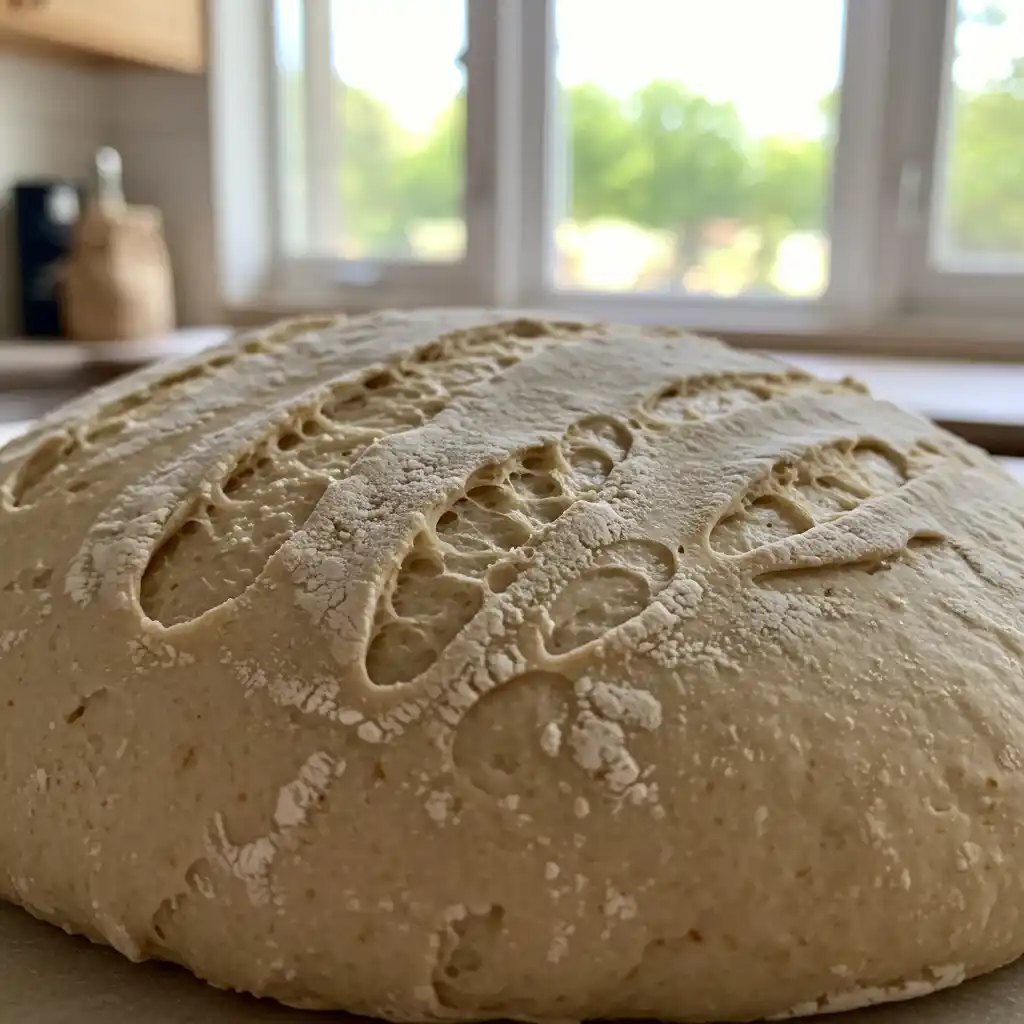
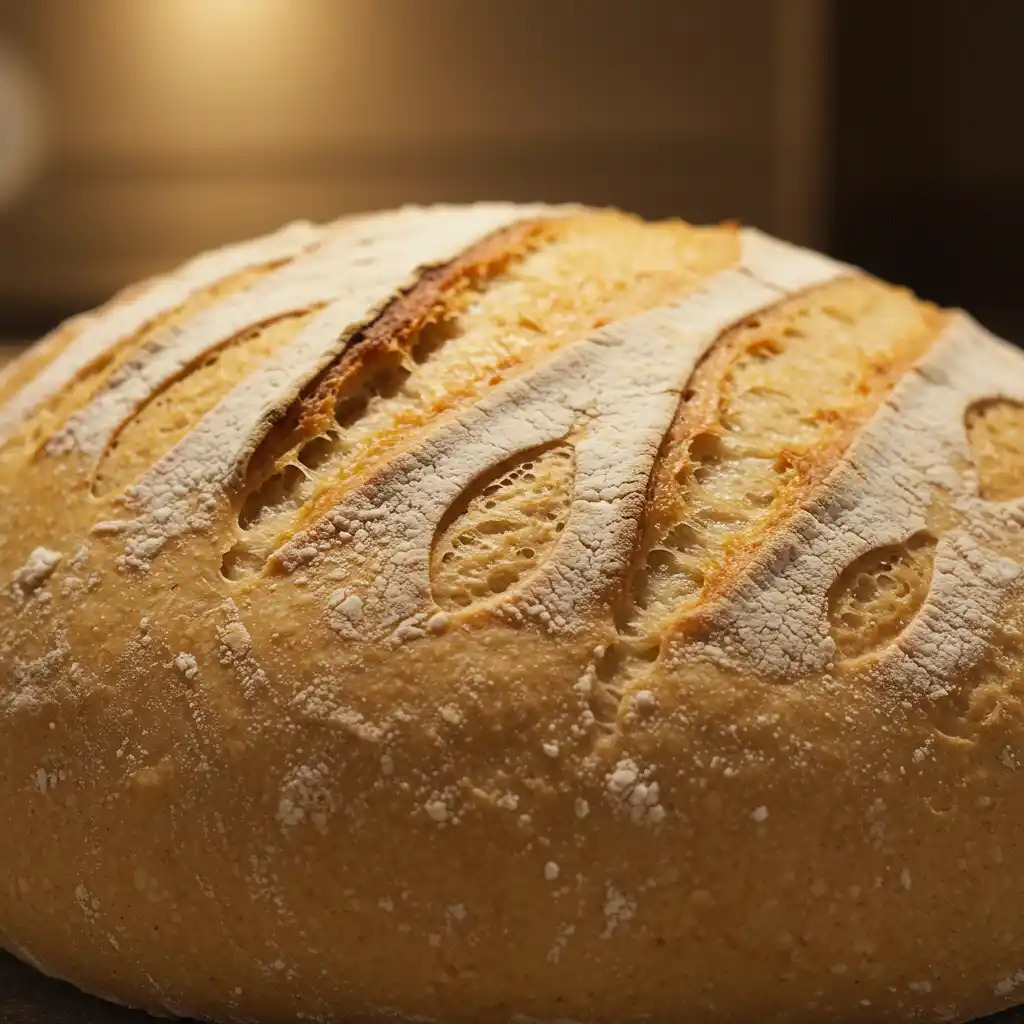
Key Ingredients You’ll Need for Sourdough Bread
Now that you’re geared up, let’s talk ingredients. Unlike commercial loaves, sourdough bread relies on simple, natural components. Here’s what you need:
1. Sourdough Starter
The heart and soul of sourdough. It’s a mix of flour and water fermented over time to grow wild yeast and lactic acid bacteria.
Don’t have one? Start your own or get some from a friend. You’ll feed it daily or weekly, depending on use.
2. High-Quality Flour
Look for unbleached bread flour with high protein (12%+). Whole wheat and rye flours are also great for flavor and fermentation power.
Types to consider:
- Bread Flour (strong gluten structure)
- Whole Wheat Flour (nutty, earthy flavor)
- Rye Flour (ferments quickly, adds depth)
3. Filtered Water
Chlorine in tap water can inhibit fermentation. Use filtered or spring water for the best rise.
4. Salt
Salt regulates fermentation and enhances flavor. Use fine sea salt or kosher salt—skip iodized table salt, which may impact your starter.
Optional Add-ins to Customize Your Loaf
Once you’ve nailed the basics, you can level up your sourdough bread with flavorful add-ins.
| Add-in | Flavor Boost |
|---|---|
| Seeds (sunflower, sesame) | Adds crunch and fiber |
| Olives or Sundried Tomatoes | Mediterranean vibes |
| Fresh herbs | Elevates the aroma |
| Cheese | Adds richness and gooey pockets |
| Nuts or Dried Fruit | Perfect for breakfast loaves |
The Golden Rule: Quality Ingredients Yield Better Bread
Remember, sourdough bread is only as good as the ingredients and care you put into it. Cheap flour, unfiltered water, or skipping key tools can result in lackluster loaves. But with just a few intentional choices, your homemade bread can rival the best bakery in town.
Quick Checklist: Starter Sourdough Kit
Here’s a compact checklist to get your sourdough journey rolling:
- ✅ Digital Scale
- ✅ Mixing Bowl
- ✅ Banneton
- ✅ Dough Scraper
- ✅ Dutch Oven
- ✅ Lame
- ✅ Thermometer
- ✅ Bread Flour
- ✅ Filtered Water
- ✅ Sea Salt
- ✅ Sourdough Starter
Learn more about our favorite artisan bread starter kits for beginners.
Why Tools and Ingredients Matter in Sourdough Success
You could bake sourdough bread with just flour, water, and salt—but the right setup makes the difference between “meh” and “marvelous.” A few small investments now pay off in every loaf you pull from the oven. And once you experience the magic of baking your first tangy, crackly sourdough loaf? You’ll never go back.
Step-by-Step Process to Bake Sourdough Bread at Home
Mastering the Art of Homemade Sourdough Bread
Now that you’re armed with all the right tools and ingredients, it’s time to roll up your sleeves and start baking! Making sourdough bread is a slow, hands-on, and deeply rewarding process. From mixing to final bake, each step plays a vital role in the bread’s flavor, structure, and signature tang.
In this section, we’ll walk through each phase so you can bake perfect sourdough bread in your own kitchen—even if it’s your very first loaf.
Step 1: Feed Your Sourdough Starter
Before baking, make sure your starter is active and bubbly. Feed it 4–6 hours before mixing your dough, using the 1:1:1 ratio (equal parts starter, flour, and water by weight).
Signs it’s ready:
- It doubles in size within 4 hours.
- Has a mildly tangy aroma.
- Passes the float test (drop a spoonful in water—it should float).
Step 2: Mix the Dough
Once your starter is active, mix your dough.
Basic Sourdough Bread Recipe:
| Ingredient | Amount |
|---|---|
| Bread Flour | 500g |
| Active Starter | 100g |
| Filtered Water | 350–375g |
| Sea Salt | 10g |
Instructions:
- Combine flour, water, and starter in a large bowl.
- Mix just until no dry flour remains.
- Let it rest (autolyse) for 30–45 minutes to hydrate the flour.
Step 3: Add Salt & Begin Bulk Fermentation
After the autolyse, sprinkle in the salt and knead it into the dough. Use the “pinch and fold” method or stretch and fold until salt is fully integrated.
Bulk Fermentation (4–6 hours):
Let the dough sit at room temperature, covered. Perform a series of 3–4 stretch-and-folds every 30 minutes to build structure.
Step 4: Pre-Shape and Bench Rest
Once bulk fermentation is complete, gently remove the dough and pre-shape it into a round. Let it rest on the counter, covered, for 20–30 minutes.
This helps the gluten relax and makes final shaping easier.
Step 5: Final Shaping and Proofing
Shape your dough into a tight round or oval (batard). Place it into a floured banneton or towel-lined bowl with the seam side up.
Proofing Options:
- Room Temp Proof: 2–3 hours, then bake.
- Cold Proof (Preferred): Cover and refrigerate for 8–18 hours. This slows fermentation and develops flavor.
Step 6: Score and Bake
Preheat your oven to 475°F (245°C) with your Dutch oven inside for at least 45 minutes.
To bake:
- Flip dough onto parchment.
- Score the top with a sharp blade to control expansion.
- Place into hot Dutch oven, cover, and bake for 20 minutes.
- Remove the lid and bake for another 20–25 minutes until golden brown and crispy.
Step 7: Let It Cool Before Slicing
As tempting as it is, don’t slice into hot sourdough bread! Let it cool on a rack for at least 1 hour. This sets the crumb and makes slicing easier.
Step-by-Step Summary Table
| Step | Time Needed | Notes |
|---|---|---|
| Feed Starter | 4–6 hrs | Float test to check readiness |
| Mix Dough | 10 min + 45 min rest | Autolyse improves hydration |
| Bulk Fermentation | 4–6 hrs | Stretch & fold every 30 mins |
| Pre-Shape & Rest | 30 min | Relaxes gluten |
| Final Shape & Proof | 2–3 hrs or overnight | Cold proof adds flavor |
| Score & Bake | 45 min–1 hr | Covered & uncovered bake |
| Cool & Slice | 1 hr | Essential for perfect texture |
Troubleshooting Common Issues
Even seasoned bakers run into snags. Here’s how to fix them:
| Problem | Likely Cause | Fix |
|---|---|---|
| Flat loaf | Over-proofed or weak gluten | Shorten proof time or strengthen dough |
| Dense crumb | Under-fermented or not enough folding | Improve bulk fermentation process |
| Pale crust | Oven not hot enough or no steam | Use Dutch oven and preheat properly |
| Gummy interior | Not fully baked | Use a thermometer, extend baking time |
Why the Process Matters in Sourdough Bread Baking
Each step from mixing to proofing affects the final flavor, crumb, and crust of your sourdough bread. Mastering the rhythm and trusting the process will help you develop your own baking intuition. And once you’ve nailed your first beautiful loaf? There’s no turning back.
Advanced Tips and Flavor Variations for Sourdough Bread
Elevate Your Sourdough Bread with These Pro Tips
Once you’ve mastered the basics of baking sourdough bread, it’s time to experiment and bring new flavors and textures to your loaves. This section shares expert tips to help you customize your sourdough bread and perfect your baking technique.
Enhancing Flavor: How to Add Depth to Your Sourdough Bread
The unique tang of sourdough bread comes from its natural fermentation, but you can amplify and vary the flavor by:
- Using different flours: Incorporate rye, whole wheat, or spelt flour to add nuttiness and complexity. Whole grain flours also boost the bread’s nutritional profile.
- Extending fermentation: Longer cold fermentation (up to 72 hours) develops more sour notes and richer aromas.
- Adding natural ingredients: Try mixing in seeds like flax, sunflower, or sesame for texture and taste. Herbs such as rosemary or thyme bring fresh, aromatic notes.
- Using starter refreshment tricks: Adjust the starter’s feeding schedule or hydration to tweak the sourness level.
Perfecting the Crust: Tips for a Crispy and Glossy Finish
Nothing beats a crusty, golden sourdough crust. To get that perfect crackle:
- Use steam: Bake with steam in the first 15–20 minutes. This keeps the crust moist and allows it to expand before hardening.
- Dutch oven baking: Baking inside a preheated Dutch oven traps steam naturally and gives an even crust.
- Scoring: Proper scoring controls oven spring and adds beautiful patterns to the crust.
- Post-bake glazing: For a shiny crust, brush the loaf with melted butter or olive oil after baking.
Common Flavor Variations to Try in Your Sourdough Bread
Experimenting with ingredients can make every loaf exciting. Here are a few popular variations:
- Olive and Rosemary Sourdough: Add chopped olives and fresh rosemary during the final mix for a Mediterranean flair.
- Cranberry Walnut Sourdough: Incorporate dried cranberries and toasted walnuts for a sweet and nutty loaf.
- Garlic and Herb Sourdough: Mix roasted garlic and Italian herbs to enhance savory notes.
- Seeded Sourdough: Mix in a combination of seeds (pumpkin, sunflower, chia) for crunch and nutrition.
Using Sourdough Bread in Recipes Beyond Toast
Don’t limit your sourdough bread to just sandwiches and toast! Here’s how to get creative:
- Sourdough croutons: Cube day-old bread, toss with olive oil and herbs, then bake for salad toppers.
- Bread pudding: Use stale sourdough for a moist, tangy bread pudding.
- Sourdough pizza crust: Stretch your dough thinner for a naturally fermented pizza base.
- French toast: The tangy crumb adds a new flavor dimension to classic French toast.
Storing and Reviving Sourdough Bread
Proper storage keeps your sourdough fresh longer:
- Short-term storage: Keep at room temperature wrapped loosely in a linen or paper bag for 2–3 days.
- Long-term storage: Freeze sliced sourdough in airtight bags. Thaw at room temp or toast directly from frozen.
- Reviving stale bread: Sprinkle water on the crust and bake at 350°F (175°C) for 10 minutes to refresh.
Tips for Consistent Results Every Time
Consistency in baking sourdough bread comes from:
- Monitoring dough hydration and ambient temperature.
- Keeping your starter healthy and active.
- Using a kitchen scale for precise measurements.
- Maintaining a baking schedule and taking detailed notes.
By following these tips, you’ll produce reliable, delicious sourdough bread loaves that impress every time.
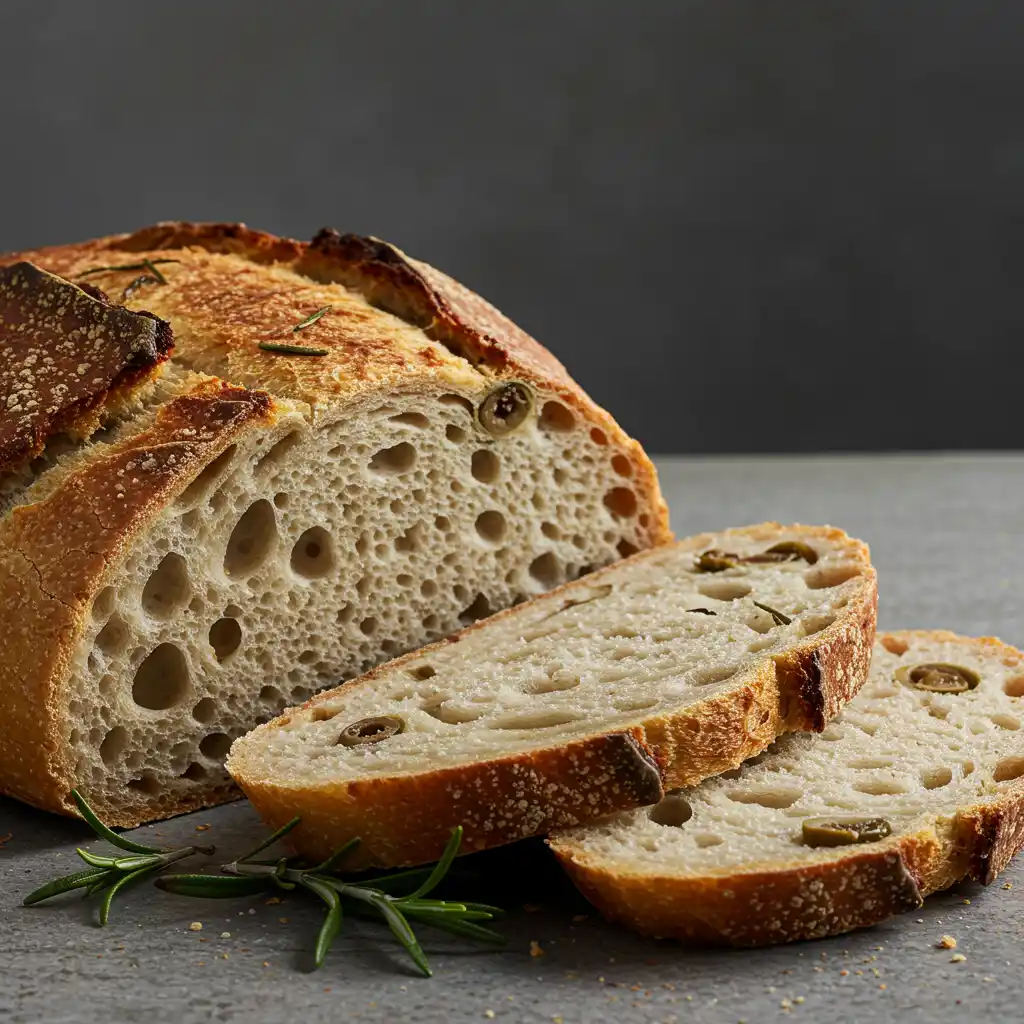
“Craving more delicious recipes? Follow me on Facebook, Pinterest, and Medium!”
Frequently Asked Questions About Sourdough Bread and Conclusion
Frequently Asked Questions About Sourdough Bread
What are the downsides of sourdough bread?
While sourdough bread offers many benefits, it has some downsides. It typically takes longer to make than commercial bread, requiring hours or even days for fermentation. Also, sourdough can be more expensive due to the labor-intensive process. Some people may find the tangy flavor too strong or may have sensitivities to gluten despite its partial breakdown.
Is sourdough anti-inflammatory?
Sourdough bread contains lactic acid bacteria and prebiotics, which may help reduce inflammation in the gut. However, it’s not a cure-all anti-inflammatory food. Eating sourdough as part of a balanced diet may support gut health, but more research is needed to confirm direct anti-inflammatory effects.
Can I eat sourdough bread every day?
Yes, eating sourdough bread daily is generally safe for most people. Its natural fermentation improves digestibility and nutrient absorption, making it a healthier bread option. However, portion control is important to balance carbohydrates and calories in your diet.
Is sourdough high in carbs?
Sourdough bread contains carbohydrates like all breads, but its carbs are often easier to digest due to fermentation. The fermentation process reduces some starch and sugars, potentially lowering the glycemic index compared to regular bread.
Why does everyone love sourdough?
People love sourdough for its unique tangy flavor, chewy texture, and health benefits. The natural fermentation improves digestibility and adds nutrients. Plus, sourdough’s artisanal nature connects bakers to traditional baking methods, which many find appealing.
Is sourdough good for diabetics?
Sourdough may be a better choice for diabetics compared to other breads. The fermentation process lowers the glycemic index, causing slower blood sugar spikes. Still, diabetics should eat it in moderation and monitor their blood sugar levels.
What is the secret to good sourdough bread?
The secret lies in a well-maintained starter, proper fermentation time, accurate hydration, and good baking technique. Patience and practice are key to achieving the perfect balance of flavor, texture, and crust.
Why is it called sourdough?
It’s called sourdough because the dough’s natural fermentation produces lactic acid, giving the bread its signature sour flavor. This fermentation is what differentiates it from breads made with commercial yeast.
Why is sourdough so expensive?
Sourdough is more expensive due to the time, skill, and ingredients involved. The slow fermentation, frequent starter maintenance, and artisanal baking methods require more labor and care than mass-produced breads.
Is sourdough bread good for losing belly fat?
While sourdough bread is healthier than many other breads, it alone won’t cause belly fat loss. A balanced diet, portion control, and regular exercise are essential. The lower glycemic index and improved digestibility may support weight management.
What is the big deal with sourdough bread?
The big deal is sourdough’s unique flavor, texture, and health benefits. It offers a natural, traditional alternative to commercial breads and connects people to centuries-old baking techniques, making it both a cultural and culinary favorite.
Conclusion: Why Sourdough Bread is Worth the Effort
Sourdough bread stands out in the world of baking thanks to its rich flavor, health benefits, and artisanal charm. Although it requires time and patience, the rewards are undeniable—a crusty, tangy loaf that’s easier to digest and more nutritious than many other breads. Whether you’re a beginner or a seasoned baker, exploring sourdough can deepen your appreciation for traditional baking and elevate your bread game.
By understanding sourdough’s fermentation process, mastering baking techniques, and experimenting with flavors, you can enjoy homemade sourdough bread that satisfies both your palate and nutritional needs. Remember, every loaf is a journey and that journey tastes delicious.
For more on baking and delicious recipes, check out our ultimate bread baking guide.
Did You Try Our Recipe?
There are no reviews yet. Be the first one to write one.



